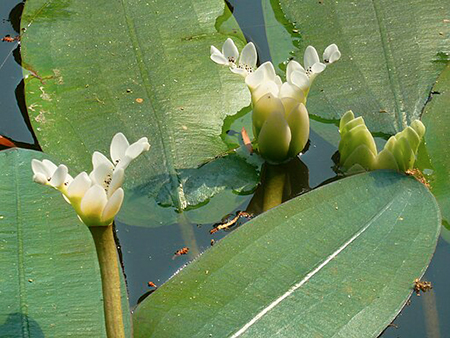
EPPO Alert List – Aponogeton distachyos (Aponogetonaceae)
Why
Aponogeton distachyos (Aponogetonaceae) is recorded as an escaped plant species in the EPPO region. The EPPO Panel on Invasive Alien Plants are seeking further information on any additional occurrences of A. distachyos in the EPPO region and reports of environmental and economic impacts.
Geographical distribution
EPPO region: Belgium, France, Ireland, Netherlands, United Kingdom.
Africa: South Africa (native).
North America: USA (California).
South America: Chile.
Oceania: Australia, New Zealand.
Morphology
Aponogeton distachyos is a hairless, aquatic perennial, with elongated stems rooted in mud at its tuberous base. Its leaves float, and are oblong-elliptic, up to 25 x 7 cm. It flowers in a forked spike at the water's surface on a long stalk, with a deciduous sheath at the base of each spike. Each spike up to 6 cm, each with up to 10 flowers; sepals 10-20 mm.
Biology and Ecology
Aponogeton distachyos is a freshwater, tuberous-rooted perennial plant with submerged and floating leaves. It can grow in water bodies up to 2 m deep. Ripe fruits can float for a short period of time before releasing negatively buoyant seeds.
Habitats
Slow moving water bodies including rivers, irrigation channels, ponds, lakes, canals and damp ditches.
Pathways for movement
Aquarium and horticultural trade, and more specifically as a pond plant. A. distachyos is utilised as an ornamental plant both outdoors and inside in aquaria. The species is a popular ornamental as it grows and flowers in the autumn and winter months. It may also be spread locally as a contaminant of recreational equipment. The plant may enter the natural environment as discarded plant waste. Natural spread is facilitated by seed production and ripe fruit can float.
Impacts
Dense mats of A. distachyos could block waterways. It can form floating mats which can reduce light transmission and may alter the quality of the water body by reducing oxygen levels. Ecosystem services can be negatively affected, for example by reducing access to the water body or blocking irrigation channels.
Control
Control is difficult due to the habitat where A. distachyos occurs. Chemical control methods are largely not applied on or near water bodies in Europe. Mechanical control can be attempted though it is difficult to remove all material from a waterbody.
Sources
Chabrol L, Guerbaa K, Raynard P (2007) Espèces nouvelles et remarquables observées en Limousin depuis 2000. Bulletin de la Société Botanique du Centre-Ouest 38, 53-72.
Gunasekera L (2003) Cape pond lily (Aponogeton distachyos): South African food plant–emerging aquatic weed in Victoria. Weedwatch 2, 6.
Millane M, Caffrey J (2014) Risk assessment of Aponogeton distachyos. Non-native species Ireland.
Patinet M, Branquart E, Monty A (2023) Invasive alien aquatic and riparian plant species – Best management practice guide. LIFE RIPARIAS project, 188 pp. https://www.riparias.be/359/

